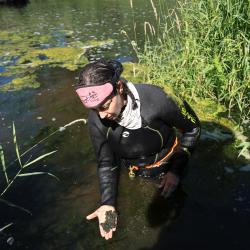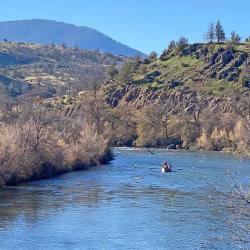
Julie Alexander
Julie Alexander
Research
I am a broadly trained aquatic ecologist with a specific interest in invertebrate hosts of Myxozoan parasites. My research interests generally lie within the field of disease ecology. I am interested in factors that drive and determine the outcomes of host-parasite interactions, how interactions may change under different environmental contexts, and how ecological and life history variables influence the evolution of host-parasite dynamics. I primarily work in freshwater systems because they are well suited to the study of disease dynamics and modeling. My methods include field-based data collection, typically by SCUBA, manipulative experiments, molecular assays for detection of hosts and parasites in environmental samples, and using modeling approaches to explore hypotheses, identify data gaps, and evaluate multi-scale abiotic and biotic interactions in aquatic systems.
My current research focuses on ecology of the invertebrate hosts of Myxozoan parasites. I am part of a dynamic research team that studies Ceratonova shasta, a myxozoan that is problematic for salmon in the Pacific Northwest. This parasite alternates between a salmon host and a freshwater annelid, and two waterborne spore stages during its life cycle. Salmonids become infected by actinospores, that are released by infected annelids, and annelids become infected by myxospores, that are released from infected fish. Interactions between the parasite and the salmonid hosts have been well studied – and factors that drive the outcome of these interactions (e.g., disease – transmission to next host, or no disease- no transmission) are reasonably well understood. However, our understanding of these same factors in the annelid host stage is hampered by a lack of understanding of the ecology of the annelid host. So, that's where I spend a lot of my time. It really is incredible how something so small can drive and determine disease risk. Please read more about it here: https://microbiology.oregonstate.edu.prod.acquia.cosine.oregonstate.edu/research/aquatic-microbiology-ecology/monitoring-studies
New Awards
Development of models for predicting annelid hosts in the Klamath River Hydroelectric Reach (Bipartisan Infrastructure Law Funds
This funding will be used to test and refine predictive models for annelid hosts in the Klamath River hydroelectric reach, which will inform and improve management decisions in the Klamath Basin. High annelid host densities, which are linked to fish disease in the Klamath River, have been described in the J.C. Boyle Bypass and Keno reaches of the Klamath River hydroelectric reach. Understanding the factors driving annelid host distribution and density in the hydroelectric reach is critical to the success of salmon recovery and future habitat restoration efforts. We previously developed a predictive model for annelids in the current infectious zone, downstream from Iron Gate Dam. This approach can be applied in the hydroelectric reach, however model performance should first be evaluated because the model may require refinement due to the unique hydraulic and sediment conditions that characterize the Klamath River hydroelectric reaches. The proposed work will build on the previous model to 1) test and refine our understanding of relationships between flow variability and the distribution and relative abundance of M. occidentalis in various habitat types, 2) contribute to a long-term data set quantifying the conditions leading to the presence of annelids and C. shasta infection, and 3) provide a tool for evaluating the potential successes proposed of flow-control or habitat restoration actions (e.g., gravel augmentation) targeted toward salmon habitat in the Klamath River hydroelectric reach and habitat restoration actions. See announcement here: https://www.fws.gov/program/klamath-basin-project-awards/what-we-do
Previous research
I have worked extensively on Tubifex tubifex, the oligochaete host of Myxobolus cerebralis in Yellowstone National Park, and more recently, in Alberta. Myxobolus cerebralis causes whirling disease in salmonid fishes. The processes that govern interactions between M. cerebralis and T. tubifex are not well understood but environment and genotype effects (and interactions between these) appear to strongly influence disease dynamics. I continue to be fascinated by this model system.
Affiliations
- American Fisheries Society (AFS)
- Society for Freshwater Science (formerly the North American Benthological Association)- this is a wonderful organization to belong to- particularly as a student member!
- Ecological Society of America (ESA)
Education
Ph.D. Montana State University
M.Sc. James Cook University
Research areas
Aquatic Microbiology and Ecology ResearchPublications
- Bartholomew, J., Alexander, J., Hallett, S., Alama-Bermejo, G., & Atkinson, S. (2022). Ceratonova shasta: A cnidarian parasite of annelids and salmonids. Parasitology, 149(14), 1862-1875. doi:10.1017/S0031182022001275
- Homel K, Alexander JD (2022) Spatiotemporal distribution of Ceratonova shasta in the lower Columbia River Basin and effects of exposure on survival of juvenile chum salmon Oncorhynchus keta. PLoS ONE 17(8): e0273438. https://doi.org/10.1371/journal.pone.0273438
- Robinson HE, Alexander JD, Bartholomew JL, Hallett SL, Hetrick NJ, Perry RW, Som NA. 2022. Using a mechanistic framework to model the density of an aquatic parasite Ceratonova shasta. PeerJ 10:e13183 https://doi.org/10.7717/peerj.13183
- James, C.T., Veillard, M.F., Martens, A.M., Pila, E A., Hanington, P., Alexander, J., and Nehring, B. 2021. Whirling Disease in the Crowsnest River: An emerging threat to wild salmonids in Southern Alberta. Canadian J. of Fisheries and Aq. Sci.
- Turecek, A., Payton, Q., Alexander, J., Goodman, D., Evans, A. and N. Som. 2021. Efficacy of reducing river flows to control parasitic salmonid diseases in the Klamath River: desiccation is not a promising management tool. Trans. of the Am. Fisheries Soc.
- Ramazi, P., Fischer, S., Alexander, J., James, C., Paul, A., Greiner, R., and Lewis, M.A. 2021. Myxobolus cerebralis establishment and spread: A graphical synthesis. Canadian J. of Fisheries and Aq. Sci.
- Robinson H. E., Alexander J.D., Hallett S.D., and Som, N.A. 2020. Prevalence of infection in hatchery-origin Chinook Salmon (Oncorhynchus tshawytscha) correlates with abundance of Ceratonova shasta spores: implications for management and disease risk. North Am. J. of Fisheries Mgmt. 40 (4) 959-972.
- Bartholomew, J.L., Atkinson, S.., Hallett, S.D., and Alexander, J.D. 2021. Myxobolus cerebralis; Chapter in Fish Parasites: A handbook of protocols for their isolation, culture and transmission, Eds. Sitja-Bobadilla, A., Bron, J.E., Wiegertjes, G., Piazzon, M.C.; 5M Books, Sheffield, UK.
- Bartholomew, J.L., Atkinson, S., Hallett, S.D. and Alexander, J.D. 2021. Ceratonova shasta; Chapter in Fish Parasites: A handbook of protocols for their isolation, culture and transmission, Eds. Sitja-Bobadilla, A., Bron, J.E., Wiegertjes, G., Piazzon, M.C.; 5M Books, Sheffield, UK.
- Alexander, J.D. and Bartholomew, J.L. 2020. Myxoboliosis (Myxobolus cerebralis). In Climate Change and Infectious Diseases, eds P. Woo, J. Leong, and K. Buchmann. CABI.
- Som, N.A., Hetrick, N.J., Perry, R.W. and Alexander, J.D. 2019. Estimating annual Ceratonova shasta mortality rates in juvenile Scott and Shasta River Coho Salmon that enter the Klamath River mainstem. U.S. Fish and Wildlife Service. Arcata Fish and Wildlife Office, Arcata Fisheries Technical Report Number TR 2019-38, Arcata, California.
- Hurst, C.N. and J.D Alexander (first coauthors), Dolan, B.P, Jia, L., and Bartholomew, J.L. 2019. Outcome of within-host competition demonstrates that parasite virulence doesn't equal success in a myxozoan model system. Intl. J. for Parasitol.: Parasites and Wildlife 9:25-35.
- Javaheri, A., Babbar-Sebens, M., Alexander, J., Bartholomew, J. and Hallett, S. 2018. Global sensitivity analysis of water age and temperature for informing salmonid disease management. J. of Hydrol, 561, 89-97.
- Alexander, J.D, Wright, K.A., Som, N.A., Hetrick, N.L. and Bartholomew, J.L. 2016. Integrating models to predict distribution of the invertebrate host of myxosporean parasites. Freshwater science 35:1263-1275.
- Foott, J.S., Stone, R., Fogerty, R., True, K., Bolick, A., Bartholomew, J.L., Hallett, S.L., Buckles, G.R. and Alexander, J.D. 2016. Production of Ceratonova shasta myxospores from salmon carcasses: Carcass removal is not a viable management option. Journal of Aquatic Animal Health, 28, 75-84.
- Som, N.A., Hetrick, N.J., and Alexander, J.D. 2016. Response to Request of Technical Assistance- Polychaete Distribution and Infection. U.S. Fish and Wildlife Service. Arcata Fish and Wildlife Office, Arcata Fisheries Technical Memorandum, Arcata, California.
- Alexander, J.D., Keransw, B.L., El-Matbouli, M., Hallett, S.L, and Stevens, S.L. 2015. Annelid-myxosporean interactions. IN: Myxozoan evolution, Ecology and Development; Okamura, B., Gruhl, A., Bartholomew, J.L. (Eds.), Springer.
- Roon, S.R., Alexander, J.D., Jacobson, K.C. and Bartholomew, J.L. 2015. Effect of Nanophyetus salmincola and Bacterial Co-Infection on Mortality of Juvenile Chinook Salmon. J. of Aquatic Animal Hlth., 27, 209-216.
- Alexander, J.D., Hallett, S.L., Stocking, R., Xue, L., and Bartholomew, J.L. 2014. Host and parasite populations after a flood. Northwest Science. 88: 219-233.
- Bjork, S.J., Zhang, Y.A., Hurst, C.N., Alonso-Naveiro, M.E., Alexander, J.D., Sunyer, J.O. and Bartholomew, J.L. 2014. Defenses of susceptible and resistant Chinook salmon Onchorhynchus tshawyscha against the myxozoan parasite Ce.
- Alexander, J.D., Hallett, S.L., Stocking, R., Xue, L., and Bartholomew, J.L. 2014. Host and parasite populations after a flood. Northwest Science. 88: 219-233.
- Bjork, S.J., Zhang, Y.A., Hurst, C.N., Alonso-Naveiro, M.E., Alexander, J.D., Sunyer, J.O. and Bartholomew, J.L. 2014. Defenses of susceptible and resistant Chinook salmon Onchorhynchus tshawyscha against the myxozoan parasite Ceratomyxa shasta. Fish and Shellfish Immunology 37(1)87-95.
- Alexander, J.D., Kerans, B.L., Koel, T.M., and Rassmussen, C. 2011. Context specific parasitism in Tubifex tubifex in geothermally influenced stream reaches in Yellowstone National Park. Journal of the North American Benthological Society 30(3)853-867.

